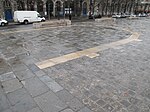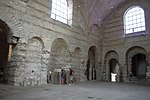2017 Notre-Dame de Paris attack
On 6 June 2017, at around 16:00 CET, French police shot a man who attacked a police officer with a hammer outside Notre-Dame de Paris cathedral on the Île de la Cité, located in the centre of Paris. The man injured the officer with the hammer, and was found to be in possession of kitchen knives. French police opened a terrorism investigation.The accused is an Algerian-born journalist named Farid Ikken, who won an award for his prize-winning human rights writing in Sweden, before returning to Algeria where he started an online news site, and then, moved to France on a student visa, he was pursuing a PhD in communications at the time of the attack. According to the prosecutor, a video in which he pledged allegiance to ISIS was found at the accused's apartment.
Excerpt from the Wikipedia article 2017 Notre-Dame de Paris attack (License: CC BY-SA 3.0, Authors).2017 Notre-Dame de Paris attack
Parvis Notre-Dame - Place Jean-Paul II, Paris 4th Arrondissement (Paris)
Geographical coordinates (GPS) Address Phone number Website Nearby Places Show on map
Geographical coordinates (GPS)
| Latitude | Longitude |
|---|---|
| N 48.853675 ° | E 2.348208 ° |
Address
Crypte Archéologique du Parvis Notre-Dame
Parvis Notre-Dame - Place Jean-Paul II
75004 Paris, 4th Arrondissement (Paris)
Ile-de-France, France
Open on Google Maps











